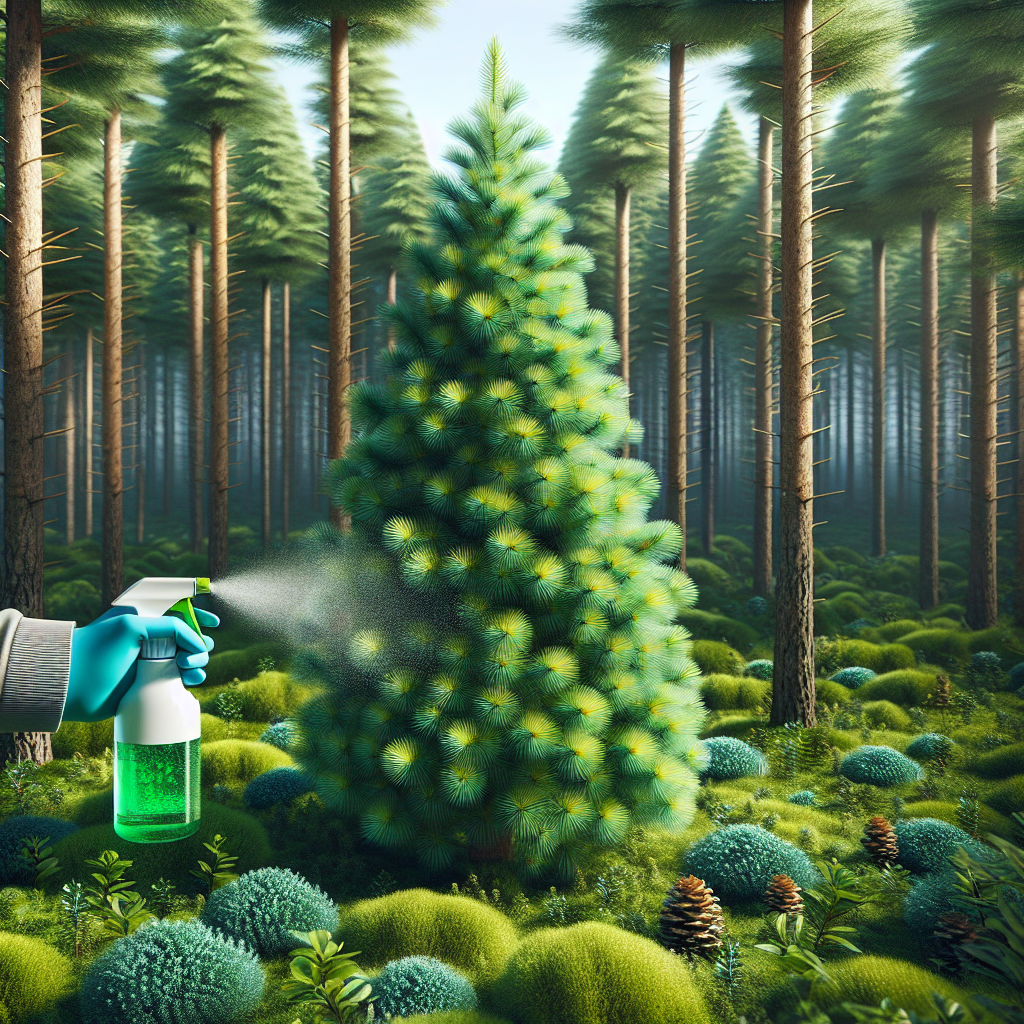Preventing Needle Cast Disease in Pine Trees
Updated June 19, 2024 at 9:17 am
Learn the effective strategies to protect your pine trees from the devastating effects of Needle Cast Disease, ensuring their health and longevity through proactive care and treatment.

Understanding Needle Cast Disease
Needle cast is a fungal disease that primarily affects coniferous trees, leaving pines and other evergreens with sparse, barren branches. It can make a once lush pine tree look sick and unattractive. Before diving into prevention, it’s crucial to understand the cause and symptoms of this disease.
The most common pathogens responsible for needle cast disease are from the genera Rhizosphaera and Lophodermium. They thrive in wet, humid conditions, so areas with prolonged damp seasons or improper tree spacing that reduces air circulation are particularly susceptible.
Recognizing the Symptoms
The earliest signs might seem harmless, being small yellow or brown spots on needles. However, as the disease progresses, these needles typically turn completely brown or reddish-brown and fall off the tree, often starting from the lower branches and moving upwards. A tree noticeably thinning in its foliage could very well be struggling with needle cast.
Upon closer inspection, small, black fruiting bodies of the fungus can be spotted on the surface of the affected needles. These are the spore-producing structures spreading the disease further by releasing spores during wet conditions.
Preventative Measures for Healthy Pines
Prevention is the best method for dealing with needle cast disease. By creating an environment that is less favorable for the fungus, you can decrease the likelihood of infection. This includes proper planting techniques, like ensuring enough space between trees for airflow and planting in well-drained soil to avoid water accumulation at the root level.
Furthermore, watering your pine trees correctly is essential. It’s better to water deeply and less frequently, which encourages strong root growth and reduces lingering dampness on the needles that fungi love.
Effective Fungicide Treatments
Fungicides can play a significant role in preventing needle cast. Applications are most effective when done in early spring, just as new needles are beginning to grow. One product that’s been well-reviewed for tackling needle cast disease is Propiconazole, a fungicide under various brand names like Quali-Pro and Banner MAXX.
For instance, Quali-Pro’s Propiconazole features a systemic formula, meaning it works from within the plant to provide protection. It’s been noted for its efficacy in stopping fungal growth and is praised for its longer residual activity.
Pros
- Effective at preventing and controlling various fungal diseases
- Systemic action allows protection from within the plant
Cons
- Must be applied with care to avoid runoff into water systems
- Repeat applications may be necessary for continued protection
From what is said, people seem to favor brewing a tank mix with a spreader-sticker additive to enhance the fungicide’s adherence to the needles, providing a more effective barrier against the fungi.
Find This and More on Amazon
Content Area 2 of 3
Choosing the Right Time for Fungicide Application
Timing is everything when it comes to applying fungicides. By targeting the early stages of needle growth, you give the new shoots a protective coating just as the fungal spores become most active. It’s commonly agreed upon that treating pines in late spring and following up in mid to late summer provides the best defense against needle cast.
Every region has its own peculiarities, regarding when fungal diseases peak. It might be beneficial for you to get in touch with your local cooperative extension service to understand better the specific timing for your area. Such foresight could save your pines from ever showing symptoms of needle cast disease.
Creating a Conducive Environment for Pine Health
Fungi such as those causing needle cast thrive in stagnant, humid air. Good air circulation is therefore paramount in any preventative strategy. Proper tree spacing is one of the simplest, yet most effective methods to ensure airflow and reduce humidity around your pines.
It could also be helpful to prune or thin out dense branches, allowing light and air to penetrate the canopy, further drying out potential hot spots for fungal growth. If you’re dealing with a more extensive landscape or forest, focusing on maintaining a diverse biosphere with a mix of tree species can also naturally inhibit the spread of needle cast disease.
Integrating Cultural Controls with Fungicides
While fungicides are an effective tool in the arsenal against needle cast, cultural practices should be your first line of defense. This means creating conditions that discourage fungal growth; proper tree care, like mulching and fertilization, should not be overlooked.
Multi-step approaches that integrate both fungicides and good cultural practices tend to create sustainable outcomes. For example, ensuring that you’re not over-mulching and accidentally keeping the soil too moist, or over-fertilizing and causing excess tender growth that’s more susceptible to diseases, are both practices that harmonize with strategic fungicide use.
Addressing Needle Cast with Natural Solutions
For those who wish to avoid chemical treatments, there are natural alternatives. Some gardeners suggest using Neem oil, a natural fungicide that comes from the seeds of the Neem tree. It has a dual action of both preventing fungal spores from germinating and deterring insects that can spread disease.
Applying a mixture of Neem oil and water to the pine’s foliage, especially after pruning or during the damp season, can serve as a barrier against needle cast fungi. Regular applications are recommended, as Neem oil degrades quickly in the environment, ensuring a lesser impact compared to long-term chemical treatments.
Monitoring and Evaluation
After implementing a prevention or treatment plan against needle cast, monitoring your pines is essential. Keep an eye on the foliage throughout the seasons, particularly in the spring and early summer when new growth occurs and spores are likely to spread.
If you detect early signs of the disease, adjust your strategies accordingly. More frequent fungicide applications, increased pruning for air circulation, or even additional soil amendments to enhance drainage might be necessary to regain control of the situation.
Consulting with Professionals
When in doubt, consulting with a certified arborist or a tree health specialist could provide invaluable insights into the health of your pines. These professionals have the expertise to diagnose the extent of needle cast infection accurately and will be able to recommend the most effective treatment plan, tailored specifically to your situation.
Arborists might also introduce you to newer, perhaps more environmentally-friendly, fungicides. Such as copper-based products, which have a broad spectrum of activity against many types of fungi and could be used as a part of an integrated management strategy against needle cast.
Long-term Management and Landscape Planning
Ultimately, the best defense against needle cast is a well-thought-out landscape plan. This may include diverse planting schemes, selecting disease-resistant pine species, and ensuring that all your plants have adequate space and resources to thrive without undue stress.
Consideration of future climate conditions can also be factored into long-term landscape planning. With changing weather patterns, preparing for increased humidity or extended rainy seasons could make a significant difference in your pine trees’ ability to resist needle cast disease.
Understanding and Working With the Ecosystem
In the quest to prevent needle cast disease, it’s valuable to take a step back and consider the broader ecosystem. Numerous organisms, including beneficial fungi and bacteria, compete with needle cast pathogens and can play a role in keeping them in check.
Encouraging a rich soil microbiome with compost and choosing mycorrhiza-friendly cultivation practices may bolster the pines’ own defenses. Ecosystem-based strategies are gaining traction among those looking for sustainable gardening and forestry practices.
“`html
Integrating Best Practices with Local Advice
Every region has distinct environmental factors that can influence the prevalence of needle cast disease. Seeking guidance from local horticulturists, arborists, or your regional cooperative extension service can provide valuable, location-specific advice on how to protect your pine trees.
These local experts can offer insights on the right tree species for your area, the best times to apply fungicides, and even tips on natural resistance varieties that might thrive in your local climate. Such tailored advice can be priceless in your fight against needle cast.
Science Behind Resistance Breeding
One promising avenue for preventing needle cast is the development of disease-resistant pine trees through scientific breeding programs. Researchers continuously work to identify genetic traits that enable certain pines to naturally ward off fungal pathogens.
By understanding these genetic factors, scientists can breed pine species with enhanced resistance to needle cast. This sort of biologically-informed approach can lead not only to healthier trees but also reduce dependency on chemical interventions in the long term.
Understanding Chemical Intervention and Ecosystem Impact
While chemical treatments are a practical solution for controlling needle cast disease, it’s crucial to consider their broader environmental impact. Fungicides can have unintended effects on non-target species, particularly beneficial organisms in the soil and nearby plants.
Adopting an integrated pest management (IPM) approach leads to more eco-friendly practices. By combining cultural controls, biological agents, and chemical products, you can manage needle cast effectively while minimizing disturbance to the ecosystem.
The Role of Community in Pine Tree Health
Managing needle cast disease isn’t just an individual effort; it benefits from community involvement. Neighbors sharing knowledge and resources, such as group purchases of fungicides or collaborative pruning efforts, help maintain the overall health of the local greenscape.
This sharing of best practices and staying informed about outbreaks can lead to more effective regional defenses against needle cast. Community forums, gardening clubs, or social media groups can be great platforms for such exchanges.
Conclusion and Content area 3 of 3
In summary, needle cast disease presents a significant threat to pine trees, but with the right knowledge and resources, it can be effectively prevented and managed. By recognizing symptoms early, implementing preventative measures, using fungicides judiciously, and integrating cultural practices, you stand a strong chance in preserving the beauty and health of your pines.
Always remember that consulting professionals, engaging in community efforts, and considering the environment when choosing treatment methods will serve you well. By doing so, you’ll not only be saving your trees but also contributing to the overall sustainability of the ecosystem they belong to.
If these strategies resonate with you, it’s also important to keep in mind that plant care extends beyond battling diseases. A holistic approach to plant health, much like the comprehensive strategies found in guides on caring for snake plants or ensuring the vitality of plants in unique conditions as detailed in how to grow cast iron plants in low light spaces, can also be very informative and empowering.
Furthermore, taking into account the broader environment, as discussed in educational pieces on creating a pollinator-friendly vegetable garden, can play a critical role in maintaining healthy plants, be they pines or perennials.
“`
Shop more on Amazon
Flowers & Plants Team
Flowers & Plants Team


